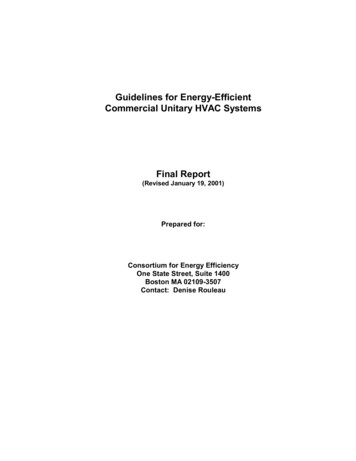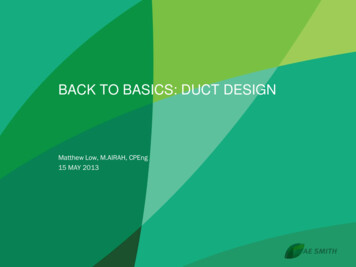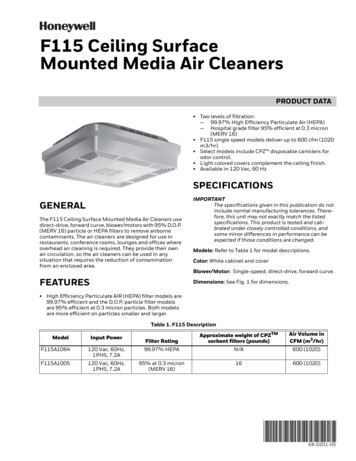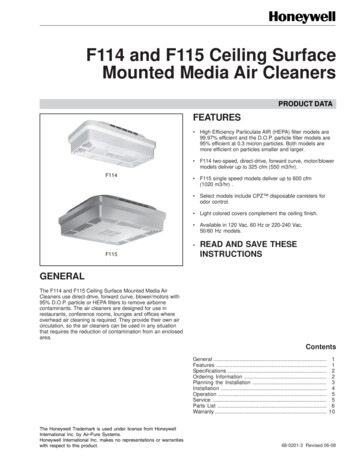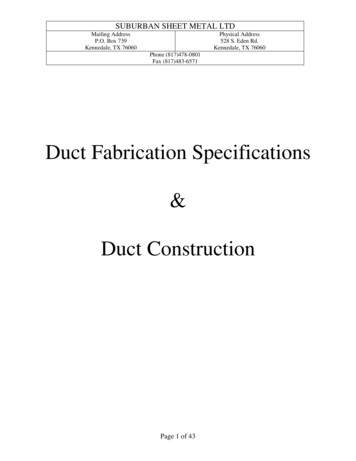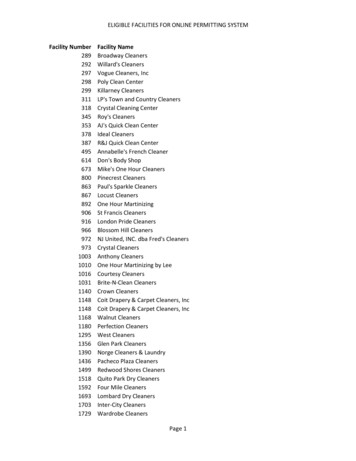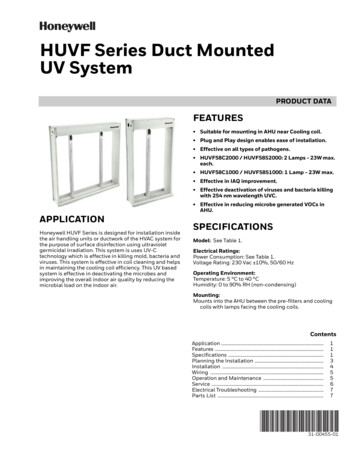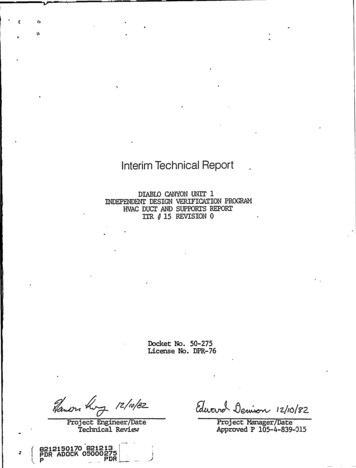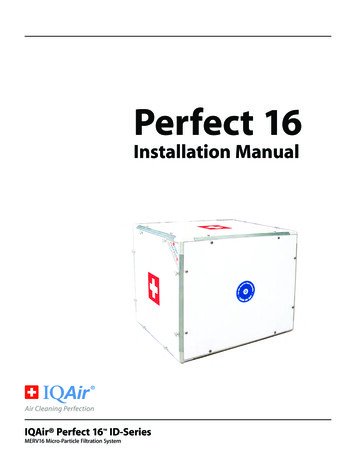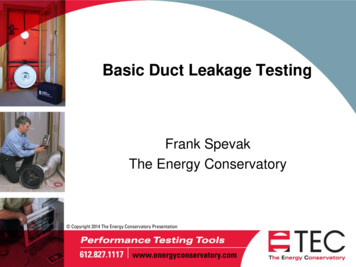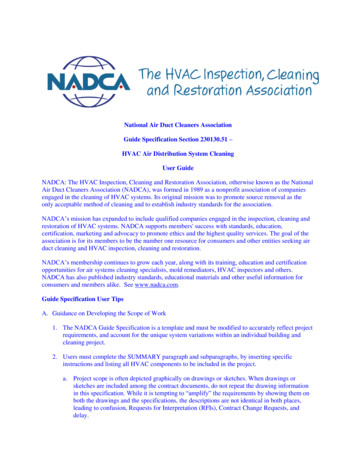
Transcription
National Air Duct Cleaners AssociationGuide Specification Section 230130.51 –HVAC Air Distribution System CleaningUser GuideNADCA: The HVAC Inspection, Cleaning and Restoration Association, otherwise known as the NationalAir Duct Cleaners Association (NADCA), was formed in 1989 as a nonprofit association of companiesengaged in the cleaning of HVAC systems. Its original mission was to promote source removal as theonly acceptable method of cleaning and to establish industry standards for the association.NADCA’s mission has expanded to include qualified companies engaged in the inspection, cleaning andrestoration of HVAC systems. NADCA supports members' success with standards, education,certification, marketing and advocacy to promote ethics and the highest quality services. The goal of theassociation is for its members to be the number one resource for consumers and other entities seeking airduct cleaning and HVAC inspection, cleaning and restoration.NADCA’s membership continues to grow each year, along with its training, education and certificationopportunities for air systems cleaning specialists, mold remediators, HVAC inspectors and others.NADCA has also published industry standards, educational materials and other useful information forconsumers and members alike. See www.nadca.com.Guide Specification User TipsA. Guidance on Developing the Scope of Work1. The NADCA Guide Specification is a template and must be modified to accurately reflect projectrequirements, and account for the unique system variations within an individual building andcleaning project.2. Users must complete the SUMMARY paragraph and subparagraphs, by inserting specificinstructions and listing all HVAC components to be included in the project.a. Project scope is often depicted graphically on drawings or sketches. When drawings orsketches are included among the contract documents, do not repeat the drawing informationin this specification. While it is tempting to “amplify” the requirements by showing them onboth the drawings and the specifications, the descriptions are not identical in both places,leading to confusion, Requests for Interpretation (RFIs), Contract Change Requests, anddelay.
b. Where possible, the drawings should show the arrangement of system components andequipment, locations, dimensions, and the extent of the work. The specifications shoulddescribe the administrative requirements, the products to be used, work procedures, andquality requirements.c. This specification is written using abbreviated language, in imperative mood. As a result,unnecessary words are omitted, and sentences generally begin with a verb.d. The phrase “The Contractor shall” does not appear in this specification because thisspecification is a set of requirements and instructions for the contractor to follow in order tocomplete the work satisfactorily.1. When the specification says “Clean HVAC system,” that statement requires the DuctCleaning Contractor to complete the work.e. The word “all” is seldom, if ever used in this section, because the requirements of the sectionapply to everything within the contract scope, unless specified otherwise.1. There is no difference between “Clean duct on 3rd Floor, West Wing” and “Clean allduct on 3rd Floor, West Wing” For that reason, “all” is not used.f.Articles like “a,” “an,” and “the” are not generally used in specifications.1. One exception to this rule is when referring to “the work,” which is the term used todenote the sum total of the products and actions required by the contract.3. Below are 10 examples of a how a Scope of Work may read.a. Clean HVAC system from point where air enters system to each point where air is dischargedfrom system.b. Clean HVAC system as indicated on Drawings.c. Clean existing supply, return and exhaust air ducts in building after building renovation iscomplete.d. Clean supply and return air ducts serviced by AHU1 and AHU2.e. Clean reheat coils and supply air ducts downstream of reheat coils that are located withinconstruction area.f.Clean air handlers and associated existing return air ducts after building renovation iscomplete.g. Clean existing air ducts and new air ducts installed during construction phase.h. Clean building exhaust systems that service floors 1 through 3 on West Wing.i.Clean air handlers and air ducts that service North Building. Seal internally-lined supply airducts with approved coating in accordance with manufacturer’s instructions. Seal edges andseams of internal duct liner in accordance with liner and sealant manufacturers’ instructions.NADCA HVAC AIR-DISTRIBUTION SYSTEM CLEANING230130.51 - ii
j.Clean fan coil units in building. Clean cabinets, coils, and blowers located within fan coilunits.k. Clean supply and return air ducts located on 23rd floor from point of connection to verticalriser in shaft to each duct termination point on 23rd floor.Copyright 2017 National Air Duct Cleaners Association. All rights reserved.NADCA HVAC AIR-DISTRIBUTION SYSTEM CLEANING230130.51 - iii
Copyright 2017 by The National Air Duct Cleaners Association (NADCA)SECTION 230130.51 - NADCA HVAC AIR-DISTRIBUTION SYSTEM CLEANINGPART 1 - GENERAL1.1SUMMARYIn the Summary Article, concisely describe the work that the Duct Cleaning Contractor must perform. Bespecific, but do not repeat requirements shown on Project Drawings. Instead, refer to the drawings todescribe the extent of the work.See “Guide Specification User Tips” on this Section’s introduction pages for guidance on describing theScope of Work.Include a brief description of special cleaning instructions. Describe special cleaning procedures andrequirements in more detail later in this specification. Be brief and specific here regarding what to clean.The rest of the Specification will describe how to clean it.A.Section includes:1. Insert one or more brief statements describing scope of duct cleaning work .The Related Requirements paragraph that follows is used when the duct cleaning work must becoordinated with other work that might not normally be associated with duct cleaning. For example, ifduct cleaning must be completed before the carpeting is installed, then subparagraph 1 below might say:“09 68 16 Sheet Carpeting.”If there are no unusual coordination requirements, delete the following paragraph and subparagraph.B.Related Requirements1. Insert specification section number and title for related work .For projects that require firm, fixed pricing, delete the following Price and Payment Procedures Article.For pricing arrangements other than firm, fixed price, retain and edit the appropriate following paragraphsto define the Price and Payment Procedures. Coordinate descriptions in this section with correspondingdescriptions in Division 01 - General Requirements.1.2REFERENCESMany aspects of this specification refer to ACR, The NADCA Standard. Do not repeat the informationfrom ACR, The NADCA Standard in this specification.A.Abbreviations and Acronyms: See ACR, The NADCA Standard.B.Reference Standards:NADCA HVAC AIR-DISTRIBUTION SYSTEM CLEANING230130.51 - 1
1.Following current standards and publications of issues currently in effect form part of thisspecification to extent specified:a.American National Standards Institute/Institute of Inspection Cleaning andRestoration Certification (ANSI/IICRC).1)b.National Air Duct Cleaners Association (NADCA):1)c.2)2)1.3HVAC Duct Construction Standards - Metal and Flexible.Underwriters’ Laboratories (UL):1)g.Cleaning Fibrous Glass Insulated Air Duct Systems.Sheet Metal and Air Conditioning Contractors' National Association (SMACNA):1)f.NFPA 90A - Standard for the Installation of Air-Conditioning andVentilating Systems.NFPA 90B - Standard for the Installation of Warm Air Heating andAir-Conditioning Systems.North American Insulation Manufacturers Association (NAIMA):1)e.ACR, The NADCA Standard - Assessment, Cleaning & Restoration ofHVAC Systems (Current Version).National Fire Protection Association (NFPA):1)d.ANSI/IICRC S520 - Standard for Professional Mold Remediation.UL Standard 181 - UL Standard for Safety Factory-Made Air Ducts andConnectors.UL Standard 181A - UL Standard for Safety Closure Systems for Use withRigid Air Ducts.US Green Building Council (USGBC):ADMINISTRATIVE REQUIREMENTSA.Coordination:1.B.Coordinate the Work of this section with the work of other trades, and the work ofdifferent contractors.Precleaning Meeting:1.2.Conduct precleaning meeting with representatives of Owner, Contractor, and facilityoccupants affected by cleaning work.Coordinate meeting date with [Owner] [Construction Manager] Insert title ofOwner’s Representative here .NADCA HVAC AIR-DISTRIBUTION SYSTEM CLEANING230130.51 - 2
C.Sequencing:1.D.Scheduling:1.1.4Perform duct cleaning work after HVAC system construction and duct leakage testing arecomplete.Prepare and submit HVAC system cleaning activities schedule in according withDivision 01 section describing project scheduling requirements.SUBMITTALSAction submittals are for components that require Owner approval before purchasing or proceeding withthe work. Because new products are seldom furnished or installed as part of the scope of work for HVACsystem cleaning, the following paragraph and subparagraphs are seldom required, and can generally bedeleted.When duct cleaning scope includes installation on new components, the Owner may require submittals ofthe following information to include in the facility maintenance records.A.Action Submittals:1.2.3.Product Data: Submit data for each product.Shop Drawings.Samples.Informational submittals are frequently required for HVAC system cleaning work. The required submittalinformation is contained in the body of this section.B.Informational Submittals:1.Duct cleaning plan: Before commencing cleaning work, submit written work planincluding following information:a.b.c.d.2.3.Scope of Work identifying HVAC components are to be cleaned, as well as thosecomponents not to be cleaned.Itemize specific environmental engineering controls required for workspace, andspecial work requirements.Detail cleaning work means and methods.Name, contact information, and functional tasks performed by each representativeof each firm and contractor involved with the work.Manufacturer’s Instructions: Submit cleaning agent product installation instructions.Field Quality Control Submittals:a.b.Submit laboratory analysis results, if NADCA Vacuum Test is used for cleanlinessverification.Submit documentation detailing chain of custody for test samples, if outsidelaboratories or testing agencies performed sample analysis or testing.NADCA HVAC AIR-DISTRIBUTION SYSTEM CLEANING230130.51 - 3
4.Qualification Statements: Show membership status, project experience, and certificationsfor:a.b.c.d.e.HVAC Cleaning Contractor.Supervisor.Inspector.Hygienist.Testing Agency.Closeout submittals represent information the Facility Owner will require for ongoing facility operation.C.Closeout Submittals:1.Record Documentation: Submit documentation verifying compliance with thisspecification for work performed. This documentation may include:a.b.c.Completion of cleaning work, as verified by [Owner’s] [ConstructionManager’s] Insert Title of Inspector here visual inspection and verification ofcleanliness.Photo images, HVAC plans and other supporting documents such as submittalforms for materials used and/or warrantees or guarantees.System areas found to be damaged or in need of repair.Quality Assurance submittals represent items the Owner requires to verify that the HVAC SystemCleaning Contractor has complied with the quality-related requirements of this section.D.Quality Assurance:1.2.Regulatory Agency Sustainability rectors.Testing Agencies.Licensed Professionals.QUALIFICATIONSA.HVAC System Cleaning Contractor: Current member of NADCA experienced in HVACcleaning projects of similar size and complexity.1.2.B.Supervisor: Employ NADCA-certified Air Systems Cleaning Specialist (ASCS)responsible for project.Inspector: Employ NADCA-Certified ASCS, or NADCA-Certified Ventilation Inspector(CVI) to perform site inspections.Licensing:NADCA HVAC AIR-DISTRIBUTION SYSTEM CLEANING230130.51 - 4
1.2.3.Submit copy of proper licenses, required to legally perform work in [State] [Province][Municipality] in which work is located.Comply with applicable federal, state, provincial, and local, rules, regulations, andlicensing requirements.Comply with requirements of Authorities Having Jurisdiction.PART 2 - PRODUCTS2.1CLEANING MATERIALSA.Cleaning Agents:B.Water: Potable.2.2TREATMENT MATERIALSA.Antimicrobial Agents: Type recommended by [Owner's] Certified Industrial Hygienist (CIH),determined from biological contamination test results.B.Sealants:2.3DUCT LINER MATERIALSA.Duct Liner: Fibrous glass insulation [matching existing] [See Section 230713 "DuctInsulation."].1.2.Where replacing internal insulation, furnish materials conforming to UL, NFPA 90A,NFPA 90B and SMACNA standards.Match thickness and insulation thermal resistance of existing duct liner.PART 3 - EXECUTIONRetain the following Article edit to list NADCA member contractors that will be considered for the work.3.1HVAC DUCT CLEANING CONTRACTORSA.3.2NADCA Member Contractors:EXAMINATIONThe following Article makes reference to Certified Industrial Hygienists (CIH), but CIH requirementswould be specified in a different section. This section does not include requirements for CIH work.A.HVAC System Assessment and Site Survey:NADCA HVAC AIR-DISTRIBUTION SYSTEM CLEANING230130.51 - 5
1.2.3.B.Before commencing work, assess HVAC system condition to determine appropriateengineering controls, safety measures, tools, equipment and cleaning products andmethods required to complete the work.Perform HVAC system assessment by ASCS, Certified Ventilation Inspector (CVI), orequivalent.If microbial testing or sampling are required, [engage] [Owner will engage] services oftechnicians trained and acceptable to authorities having jurisdiction.Work Plans:1.Project Schedule: Outline starting date, dates and times when work will take place, andcompletion date.a.2.3.Product Data and Safety Data Sheets: Product data submittals listing general use andspecific chemical cleaning products and coatings used while performing the work, alongwith Safety Data Sheets for chemical products used to perform the work.Safety Plan: Define responsibilities of each organization’s designated representativeinvolved with executing work plan throughout project.a.3.3Determine sequence of cleaning each system or portion of the work and coordinatewith work of other trades and activities.Include disclaimers identifying items not covered under project warranty orguarantee.PROTECTION OF IN-PLACE CONDITIONSA.Protect existing structures, surfaces, and systems from damage resulting from duct cleaningwork.B.Report damage caused by this work to [Owner] [Construction Manager] Insert title ofOwner’s Representative here .3.4HVAC SYSTEM PREPARATIONA.Service Openings:1.2.3.4.Access duct cleaning work through existing or new service openings, allowing safeaccess and thorough cleaning throughout specified components.Work through service openings sized to allow mechanical tool entry and visualinspection, as required for cleaning activities.Where possible, work through existing service openings.Where new service openings are required, install openings as follows:a.b.Do not degrade structural, thermal, or functional system integrity, and comply withapplicable SMACNA duct construction methods.Install service openings complying with UL and NFPA standards, federal, state,and local code requirements, and requirements of Authorities Having Jurisdiction.NADCA HVAC AIR-DISTRIBUTION SYSTEM CLEANING230130.51 - 6
c.d.e.f.g.h.i.Where required, install duct access doors complying with UL Standard 181, andfabricated with materials classified for flammability and smoke developed.Where required, install tapes complying with UL 181A.Where required, install closure panels fabricated from equivalent material andsame or heavier gage.Mechanically fasten closure panels over service openings with screws or rivets atperimeter, maximum [4 inches] [100 mm] spacing.Fabricate closure panel to overlap duct opening perimeter, minimum [1 inch] [25mm] .Insulate closure panels to match adjacent duct interior and exterior surfaces.Seal rigid fibrous glass duct systems in accordance with NAIMA recommendedpractices.1)j.5.Mark outside of duct and report service opening locations to Owner in projectcloseout documents.Do not cut service openings into flexible duct.a.b.3.5Close service openings installed in rigid fibrous glass ductwork and metalductwork with fibrous glass liner with no exposed fibrous glass edges exposed toairstream.Install service openings that can be reopened for future inspection or remediation.a.6.Install closure techniques: UL Standard 181 or UL Standard 181A.Disconnect flexible duct at both ends as required for inspection and cleaning.Reconnect flexible duct ends in accordance with SMACNA standards.CLEANING EQUIPMENT MAINTENANCE AND USEA.Maintain equipment employed in work performance in good working order, consistent withequipment manufacturer’s written instructions and applicable jurisdictional requirements.B.Clean and inspect equipment before bringing to work site.C.Do not introduce contaminants from cleaning equipment into indoor environment or HVACsystem.D.Service equipment to limit possible HVAC system contamination from insufficient serviceequipment cleaning, and unsafe operating conditions for service personnel and buildingoccupants.E.Perform activities requiring opening contaminated vacuum collection equipment on-site,including servicing or filter maintenance, in appropriate containment area or outside building.F.Clean and seal collection devices, vacuums and other tools and devices before relocating todifferent building areas, moving equipment through occupied spaces, and before removingequipment from building.NADCA HVAC AIR-DISTRIBUTION SYSTEM CLEANING230130.51 - 7
G.Locate fuel-powered equipment to prevent combustion emissions and air exhaust emissionsfrom entering building envelope.1.H.3.6Monitor and manage equipment operation and location to prevent introduction ofcombustion emissions into occupied space.Furnish HEPA-filtered equipment with minimum collection efficiency of 99.97 percent at 0.3micron particle size, when vacuum collection equipment exhausts within building envelope.CLEANING - GENERALA.Perform HVAC system cleaning in accordance with ACR, The NADCA Standard.B.Remove visible non-adhered particulates.1.Clean HVAC components employing agitation device to dislodge contaminants fromHVAC component surface, and then capturing contaminants with vacuum collectiondevice.a.2.3.4.5.C.Acceptable methods include those that do not damage integrity of ductwork andother system components, and does not damage porous surface materials includinginternal insulation and duct lining.Clean HVAC components using source removal mechanical cleaning methods designedto extract contaminants from within HVAC system and safely remove contaminants fromfacility.Select source removal methods rendering HVAC system visibly clean and capable ofpassing cleanliness verification methods as described in ACR, The NADCA Standard.Do not employ cleaning method, or combination of methods, that can damage HVACsystem components or negatively alter system integrity.Do not damage HVAC system and components with wet cleaning, power washing, steamcleaning and other wet process cleaning.Apply cleaning materials in accordance with manufacturer's instructions.1.Do not apply cleaning agents or water to electrical, fibrous glass or other porous HVACsystem components.D.Capture removed contamination and cleaning materials and legally dispose.E.Verify HVAC system surface and component cleanliness in accordance NADCA Standard.F.Particulate Collection:1.Employ contaminant removal methods incorporating vacuum collection devices operatedcontinuously during cleaning.a.Connect vacuum collection device to component being cleaned through serviceopening.NADCA HVAC AIR-DISTRIBUTION SYSTEM CLEANING230130.51 - 8
b.2.When possible, discharge ducted exhaust air from vacuum collection devices outdoors,keeping discharge air clear of outdoor air intakes, operable windows, and other locationsallowing outdoor air entry.a.b.3.Employ vacuum collection device of sufficient capacity to maintain areas beingcleaned under negative pressure, containing debris is contained and preventingcontaminant migration to adjacent areas.Do not violate outdoor environmental standards, codes or regulations.Do not discharge unfiltered air from vacuum collection devices outdoors.When necessary to exhaust vacuum collection devices indoors, including hand-held andwet-vacuum machines, keep discharge air in work area, and provide machine airdischarge HEPA filtration, rated at 99.97 percent collection efficiency for 0.3 micronparticles and larger.Retain the following paragraph and subparagraphs when the work includes AHU cleaning. Otherwise,delete.3.7AIR HANDLING UNIT (AHU) CLEANINGA.Clean supply, [return] [relief], and [exhaust] fans and blowers.1.2.Clean blowers, fan housings, ducted plenums, scrolls, blades, or vanes, shafts, baffles,dampers and drive assemblies.Remove visible non-adhered particulate deposits in accordance with ACR, The NADCAStandard.B.Clean air handling unit (AHU) internal surfaces, components and condensate pans, and drains.C.Clean heat transfer coils, fans, condensate pans, drains and similar non-porous surfaces inconjunction with mechanical methods as described in ACR, The NADCA Standard.D.Control water spray and extraction are sufficient to collect debris and prevent water damage toHVAC components and surrounding equipment.E.Capture, contain, test and dispose of waste water generated while performing wet cleaning inaccordance with applicable federal, state, and local regulations, and requirements of AuthoritiesHaving Jurisdiction.F.After cleaning, verify HVAC system surface and component cleanliness in accordance ACR,The NADCA Standard.Retain the following paragraph and subparagraph when the work includes air duct cleaning. Otherwise,delete.3.8AIR DUCT SYSTEMS:A.Clean air ducts to remove non-adhered substances.NADCA HVAC AIR-DISTRIBUTION SYSTEM CLEANING230130.51 - 9
B.Access air duct interiors through service openings in system that are large enough toaccommodate mechanical cleaning procedures and allow for cleanliness verification.C.Use mechanical agitation methods to remove particulate, debris, and non-adhered particulate.D.Capture dislodged substances with vacuum collection device.E.Do not employ cleaning methods that damage HVAC components.F.Mark position of dampers and air-directional mechanical devices inside HVAC system prior tocleaning.G.When cleaning is complete, restore dampers and devices to their marked positions.H.After cleaning, verify cleanliness of HVAC system surfaces and components in accordanceACR, The NADCA Standard.Retain the following paragraph and subparagraph when the work includes AHU coil cleaning. Otherwise,delete.3.9AHU COILSA.Perform visual coil and drain pan inspection to determine whether Type 1 dry cleaning, or Type2 wet cleaning is required.B.Employ cleaning methods rendering coil visibly clean in accordance with ACR, The NADCAStandard.C.Isolate coil from duct system during cleaning process. Do not allow removed particles tomigrate to, or redeposit on, unintended areas.D.Apply coil cleaning products in accordance with manufacturer’s published data and labeling.E.Clean and flush condensate drain pan and drain line. Verify proper drainage operation beforeand after cleaning.F.Apply cleaning methods and products that do not cause damage to, or erosion of, coil surface orfins.3.10TYPE 1 DRY CLEANING METHODA.Operate HEPA-filtered negative air machines that discharge continuously during Type 1cleaning process.B.Mechanically remove adhered dirt and contaminants in accordance with ACR, The NADCAStandard.NADCA HVAC AIR-DISTRIBUTION SYSTEM CLEANING230130.51 - 10
3.11TYPE 2 WET CLEANING METHODA.Employ Type 2 wet cleaning method when visual inspection reveals suspect microbial matteron coil or drain pan. Access both upstream and downstream sides of each coil section forcleaning.B.Employ engineering controls required for coil cleaning in accordance with ACR, The NADCAStandard.C.Verify cleanliness after cleaning has been performed as described in ACR, The NADCAStandard.D.Perform Type 2 cleaning if debris still remains on the coil or the coil is impacted after Type 1cleaning has been completed and post-cleaning inspection has been performed.E.After cleaning, verify cleanliness of HVAC coils in accordance ACR, The NADCA Standard.Retain the following paragraph and subparagraph when the work includes duct-mounted, inline coilcleaning. Otherwise, delete.Retain the options in the following subparagraphs if the inline coils have drain pans. Otherwise, delete.3.12DUCT-MOUNTED INLINE COILSA.Perform visual inspection of coil [and drain pan] to determine whether Type 1 dry cleaning, orType 2 wet cleaning is required.B.Employ cleaning methods which will render coil visibly clean in accordance with ACR, TheNADCA Standard.C.Isolate coil from duct system during cleaning process. Do not allow removed particles tomigrate to, or redeposit on, unintended areas.D.Apply coil cleaning products in accordance with manufacturer’s published data and labeling.E.Clean and flush coil [, condensate drain pan and drain line. Verify proper drainage operationbefore and after cleaning].F.Apply cleaning methods and products that do not cause damage to, or erosion of, coil surface orfins.G.Type 1 Dry Cleaning Method:1.2.H.Operate negative air machines with HEPA-filtered discharge continuously during Type 1cleaning process.Mechanically remove adhered dirt and contaminants in accordance with ACR, TheNADCA Standard.Type 2 Wet Cleaning Method:NADCA HVAC AIR-DISTRIBUTION SYSTEM CLEANING230130.51 - 11
1.2.3.4.5.I.Employ Type 2 wet cleaning method when visual inspection reveals suspect microbialmatter on coil or drain pan. Access both upstream and downstream sides of each coilsection for cleaning.Employ engineering controls required for coil cleaning in accordance with ACR, TheNADCA Standard.Verify cleanliness after cleaning has been performed as described in ACR, The NADCAStandard.Perform Type 2 cleaning if debris still remains on the coil or the coil is impacted afterType 1 cleaning has been completed and post-cleaning inspection has been performed.Capture rinse water when cleaning duct mounted coils without drain pans. Do not allowwater to remain in cleaned ductwork.After cleaning, verify cleanliness of HVAC coils in accordance ACR, The NADCA Standard.Retain the following paragraph and subparagraph when the work includes electric resistance coilcleaning. Otherwise, delete.3.13ELECTRIC RESISTANCE COILSA.De-energize, lock out, and tag out power source to coil.B.Employ Type 1 dry cleaning methods.C.Employ cleaning methods which will render coil visibly clean in accordance with ACR, TheNADCA Standard.D.Isolate coil from duct system during cleaning process. Do not allow removed particles tomigrate to, or redeposit on, unintended areas.E.Apply coil cleaning products in accordance with manufacturer’s published data and labeling.F.Apply cleaning methods and products that do not cause damage to, or erosion of, coil surface orfins.G.Type 1 Dry Cleaning Method:1.2.H.Operate negative air machines with HEPA-filtered discharge continuously during Type 1cleaning process.Mechanically remove adhered dirt and contaminants in accordance with ACR, TheNADCA Standard.After cleaning, verify cleanliness of HVAC coils in accordance ACR, The NADCA Standard.Retain the following paragraph and subparagraph when the work includes internal insulation and linings.Otherwise, delete.NADCA HVAC AIR-DISTRIBUTION SYSTEM CLEANING230130.51 - 12
3.14INTERNALLY Employ cleaning methods that do not damage internal insulation or sound attenuatingcomponents, and that render system capable of passing cleanliness verification tests.B.Clean fibrous glass duct liner or duct board present in equipment or air ducts employingmechanical agitation methods to remove particulate, debris, and non-adhered particulate.C.Do not create abrasions, breaks, or tears to fibrous glass liner or duct board surfaces.D.Maintain HVAC system under constant negative pressure when cleaning internal insulationcomponents.E.Do not wet insulation components.F.Identify for replacement fibrous glass materials with evidence of damage, deterioration,delaminating, friable materials, biological growth, or moisture that cannot be restored bycleaning or resurfacing.G.When required, remediate exposed, damaged insulation exposed to HVAC system air stream.1.2.Scrape insulation and adhesive residue from metal duct system surfaces that haveundergone degraded insulation removal.Remove loose, visible debris prior to installation of new insulation.Retain the following paragraph if mold-contaminated duct liner was removed. Otherwise, delete.3.Where biologically contaminated insulation was removed, apply antimicrobial agents toremove traces of contamination or abate mold in accordance with ANSI/IICRC S520.Retain the following paragraph if restoration of duct lining is required. Otherwise, delete.4.3.15A.When replacement insulation installation is complete, verify that new fibrous glasssurfaces are capable of compliance with NADCA cleanliness verification requirements.SPECIAL TECHNIQUESEngineering Controls:1.Employ engineering controls to maintain worker and building occupant safety, andprevent contaminating surfaces outside work area.a.b.B.Comply with government regulations, an
National Air Duct Cleaners Association Guide Specification Section 230130.51 - HVAC Air Distribution System Cleaning User Guide NADCA: The HVAC Inspection, Cleaning and Restoration Association, otherwise known as the National Air Duct Cleaners Association (NADCA), was formed in 1989 as a nonprofit association of companies
